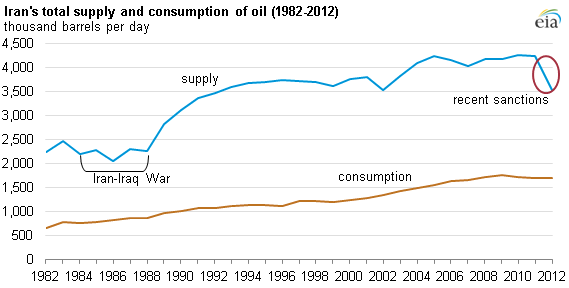Iran’s oil production dropped 17 percent in 2012, according to a new according to a new report by the U.S. Energy Information Administration. But Iran managed to remain the second-largest crude oil producer in the Organization of the Petroleum Exporting Countries on average. Consumption of liquid fuels fell one percent in 2012. The following is a chart and excerpt from the report.

Iran's exports of crude oil and lease condensate declined to approximately 1.5 million barrels per day (bbl/d) in 2012, compared to 2.5 million bbl/d in 2011. This 39% decline in exports was coupled with a 17% drop in crude oil and condensate production and a 1% decline in liquid fuels consumption including gasoline, diesel, jet fuel, and other products.
While the world's supply of oil increased by about 2%, or 1.8 million bbl/d in 2012, oil production in Iran declined by nearly 700,000 bbl/d from the 2011 level. Most of the 2012 drop in production is attributable to tightened sanctions. A smaller decline in 2011 resulted mainly from declining production in aging fields. Iran remained the second-largest OPEC crude oil producer on average during 2012, but it exceeded Iraq's production only narrowly. In August 2012, Iran's monthly crude oil production fell below Iraq's for the first time since 1989.
A new set of sanctions by the European Union became effective on April 1, 2013. The new sanctions bar EU insurance companies from providing coverage to any refiner and refinery operators that process crude oil of Iranian origin. The new provision will mostly affect refiners in South Korea and India, which rely heavily on European insurance providers. The new sanctions may further affect Iran's exports and production over the next few months as refiners try to find alternative suppliers of insurance.
Part I: Iran Oil Sales Plummet
Click here for the full report.
